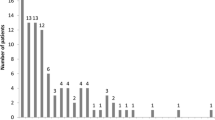Abstract
Purpose
To determine if a novel individualized-ultrasound (IUS) method can detect more joints with erosion(s) in rheumatoid arthritis (RA) patients versus existing methods.
Materials and methods
The IUS method selects up to 7 or 14 ultrasonographically most inflamed joints whereas existing methods pre-fix 7 or 14 joints for ultrasonography. Using ultrasonography, the mean total inflammatory score (TIS), mean number of affected joints and mean number of joints with erosion(s) were compared between novel and existing methods among 30 RA patients using the paired Student t test.
Results
Using 7-joint approach, comparing IUS versus existing methods, the mean (95% CI) for TIS, number of affected joints, and number of joints with erosion(s) were: 2.18 (1.88, 2.48) versus 0.95 (0.78, 1.11); 7 (7, 7) versus 4.43 (3.93, 4.94); 3.20 (2.44, 3.96) versus 1.33 (0.94, 1.72), respectively. Using 14-joint approach, comparing IUS versus existing methods, the mean (95% CI) for TIS, number of affected joints, and number of joints with erosion(s) were: 3.17 (2.75, 3.6) versus 1.71 (1.38, 2.04); 13.5 (13.05, 13.95) versus 8.13 (7.24, 9.02); 4.23 (3.13, 5.34) versus 2.77 (2.03, 3.50), respectively. p values all < 0.0001.
Conclusions
A novel IUS method detects substantially more joints with erosion(s) in RA patients versus existing methods.

Similar content being viewed by others
References
Smolen JS, Landewé R, Bijlsma J, Burmester G, Chatzidionysiou K, Dougados M, et al. EULAR recommendations for the management of rheumatoid arthritis with synthetic and biological disease-modifying antirheumatic drugs: 2016 update. Ann Rheum Dis. 2017;76(6):960–77.
Baker JF, Tan YK, Conaghan PG. Monitoring in established RA: role of imaging and soluble biomarkers. Best Pract Res Clin Rheumatol. 2015;29(4–5):566–79.
Colebatch AN, Edwards CJ, Østergaard M, van der Heijde D, Balint PV, D'Agostino MA, et al. EULAR recommendations for the use of imaging of the joints in the clinical management of rheumatoid arthritis. Ann Rheum Dis. 2013;72(6):804–14.
Wakefield RJ, Balint PV, Szkudlarek M, Filippucci E, Backhaus M, D'Agostino MA, et al. Musculoskeletal ultrasound including definitions for ultrasonographic pathology. J Rheumatol. 2005;32(12):2485–7.
Tan YK, Conaghan PG. Imaging in rheumatoid arthritis. Best Pract Res Clin Rheumatol. 2011;25:569–84.
Mandl P, Naredo E, Wakefield RJ, Conaghan PG, D’Agostino MA, OMERACT Ultrasound Task Force. A systematic literature review analysis of ultrasound joint count and scoring systems to assess synovitis in rheumatoid arthritis according to the OMERACT filter. J Rheumatol. 2011;38:2055–62.
Naredo E, Gamero F, Bonilla G, Uson J, Carmona L, Laffon A. Ultrasonographic assessment of inflammatory activity in rheumatoid arthritis: comparison of extended versus reduced joint evaluation. Clin Exp Rheumatol. 2005;23:881–4.
Tan YK, Allen JC Jr, Lye WK, Conaghan PG, D'Agostino MA, Chew LC, et al. Novel ultrasound joint selection methods using a reduced joint number demonstrate inflammatory improvement when compared to existing methods and disease activity score at 28 joints. J Rheumatol. 2016;43:34–7.
Tan YK, Allen JC Jr, Lye WK, Conaghan PG, Chew LC, Thumboo J. Dichotomous versus semi-quantitative scoring of ultrasound joint inflammation in rheumatoid arthritis using novel individualized joint selection methods. Clin Rheumatol. 2017;36:1137–41.
Backhaus M, Burmester GR, Gerber T, Grassi W, Machold KP, Swen WA, et al. Guidelines for musculoskeletal ultrasound in rheumatology. Ann Rheum Dis. 2001;60:641–9.
Backhaus M, Ohrndorf S, Kellner H, Strunk J, Backhaus TM, Hartung W. Evaluation of a novel 7-joint ultrasound score in daily rheumatologic practice: a pilot project. Arthritis Rheum. 2009;61:1194–201.
Hammer HB, Bolton-King P, Bakkeheim V, Berg TH, Sundt E, Kongtorp AK, et al. Examination of intra and interrater reliability with a new ultrasonographic reference atlas for scoring of synovitis in patients with rheumatoid arthritis. Ann Rheum Dis. 2011;70:1995–8.
Conaghan PG, O’Connor P, McGonagle D, Astin P, Wakefield RJ, Gibbon WW, et al. Elucidation of the relationship between synovitis and bone damage: a randomized magnetic resonance imaging study of individual joints in patients with early rheumatoid arthritis. Arthritis Rheum. 2003;48:64–71.
Østergaard M, Hansen M, Stoltenberg M, Gideon P, Klarlund M, Jensen KE, et al. Magnetic resonance imaging determined synovial membrane volume as a marker of disease activity and a predictor of progressive joint destruction in the wrists of patients with rheumatoid arthritis. Arthritis Rheum. 1999;42:918–29.
Szkudlarek M, Terslev L, Wakefield RJ, Backhaus M, Balint PV, Bruyn GA, et al. Summary findings of a systematic literature review of the ultrasound assessment of bone erosions in rheumatoid arthritis. J Rheumatol. 2016;43:12–211.
Døhn UM, Ejbjerg BJ, Court-Payen M, Hasselquist M, Narvestad E, Szkudlarek M, et al. Are bone erosions detected by magnetic resonance imaging and ultrasonography true erosions? A comparison with computed tomography in rheumatoid arthritis metacarpophalangeal joints. Arthritis Res Ther. 2006;8:R110.
Wakefield RJ, Gibbon WW, Conaghan PG, O'Connor P, McGonagle D, Pease C, et al. The value of sonography in the detection of bone erosions in patients with rheumatoid arthritis: a comparison with conventional radiography. Arthritis Rheum. 2000;43:2762–70.
Acknowledgements
The authors would like to thank the colleagues and the staff from the study site for all the support and help that has been rendered in the conduct of this research study.
Funding
Nil.
Author information
Authors and Affiliations
Corresponding author
Ethics declarations
Conflict of interest
The authors declare that they have no conflict of interest.
Ethical statement
Informed consent was obtained from all individual participants included in the study. All procedures performed in studies involving human participants were in accordance with the ethical standards of the institutional and/or national research committee and with the 1964 Helsinki declaration and its later amendments or comparable ethical standards.
Additional information
Publisher's Note
Springer Nature remains neutral with regard to jurisdictional claims in published maps and institutional affiliations.
About this article
Cite this article
Tan, Y.K., Li, H., Allen, J.C. et al. Detecting joints with erosion(s) in rheumatoid arthritis: a novel individualized-ultrasound method performs better than existing methods. Jpn J Radiol 37, 793–797 (2019). https://doi.org/10.1007/s11604-019-00870-y
Received:
Accepted:
Published:
Issue Date:
DOI: https://doi.org/10.1007/s11604-019-00870-y




